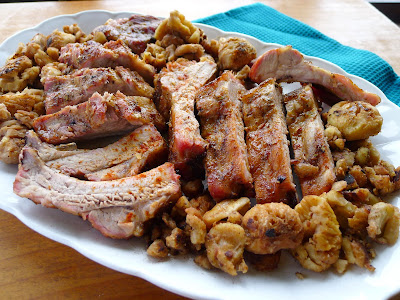 |
| Choose several apple varieties for making this dessert. |
I can’t believe there’s NO butter! Cakes, pastries, cookies—all made with extra virgin olive oil as the only fat. Yes!
For several years now, the only fat I use in my kitchen is olive oil. No butter, no vegetable oils, no lard. Why? For me, it’s a way of affirming my Mediterranean lifestyle. I pick my own olives, bring home the oil. Plus, I know how healthful olive oil (a mono-unsaturated fat) is. And, personally, I love its flavor.
At the beginning of my conversion, it was easy to switch to olive oil in cooking. Olive oil is splendid in sauces, drizzled on vegetables (or popcorn), for sautéing, for stir-frying, for deep frying. But, when it came to baking—birthday cakes and Christmas cookies—I reverted to butter.
Spanish cuisine—especially that of Andalusia, southern Spain, where olives are cultivated—has a long and respected history of preparing pastries with olive oil. But, I wanted to bake the American pastries that I grew up with (I’m from midwest America).
 |
| Olive oil, flour and oats for apple crumble. |
Next, I experimented with olive oil pie crust. It has a crisp and crackly texture, very appetizing, although different from a “flaky” one. Best of all, it is easy, easy and exceptionally good with fruit pies. Here too, I might add an inflection of aniseed or sesame as a complement.
Since then I’ve substituted olive oil for butter in all sorts of recipes for baked goods. I like it best with anything with fruit, especially citrus, or spice or chocolate. The basic substitution is ½ cup olive oil for 1 stick of butter. But, in fact, because olive oil is liquid and butter congeals, it’s better to use less oil in proportion to butter in any recipe.
 |
| Sweet apples and a crumbly topping with almonds, good hot or cold. |
Here’s an interpretation of old-fashioned Apple Crumble, using olive oil. I made this for dessert on Thanksgiving and it was a hit. The apple crumble is good served hot or cold, accompanied by ice cream. I served it with leche merengada, cinnamony iced meringue milk. That recipe can be found here.
 | ||
| Crumbly almond-oat topping with sweet apples and cinnamony ice cream. |
Apple-Almond Olive Oil Crumble
Use two or more varieties of apples, such as Gala, Granny Smith, Fuji, Pink Lady.
If you’re preparing this as part of an oven meal, the crumble can bake alongside a roast chicken at 350º or by itself at 425º. Adjust the baking time up or down.
You may like this dessert more or less sweet, so taste the apples as you add the sugar. Personally, I like it less sweet.
For the topping:
1 cup flour
½ cup rolled oats
1/3 cup sugar (white or brown), or to taste
½ teaspoon cinnamon
Pinch of ground cloves
¼ teaspoon salt
1/3 cup extra virgin olive oil
½ cup chopped almonds
Combine the flour, oats, sugar, cinnamon, cloves and salt in a bowl. Add the olive oil and stir with a fork until the mixture is crumbly. Stir in the chopped almonds. Stir to break up clumps to pea-size bits.
For the apples:
2 ½ pounds apples (about 6)
1 teaspoon grated lemon zest
4 tablespoons lemon juice
1 tablespoon flour
2 teaspoons cinnamon
1 teaspoon allspice
½ teaspoon ground ginger
½ cup sugar (white or brown), or to taste
Peel and core the apples. Slice them thinly. Combine in a bowl with the lemon zest, juice, flour, cinnamon, allspice, ginger and sugar.
Preheat oven to 350ºF.
Spread the apple mixture in an oiled 12-inch baking dish. The apples will shrink as they bake. Use the fingers to crumble the topping mixture on top. Pat it down gently.
Bake until apples are bubbling and topping is golden around the edges, about 50 minutes. Serve hot or cold.














